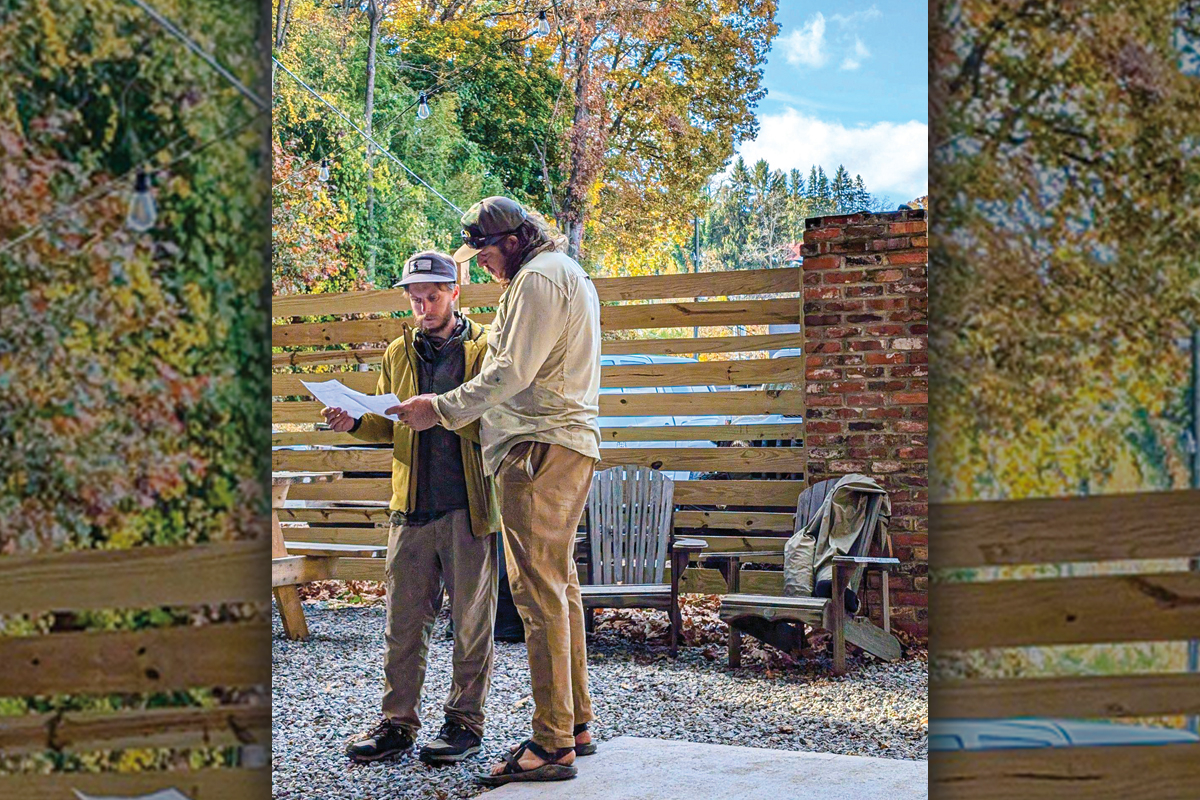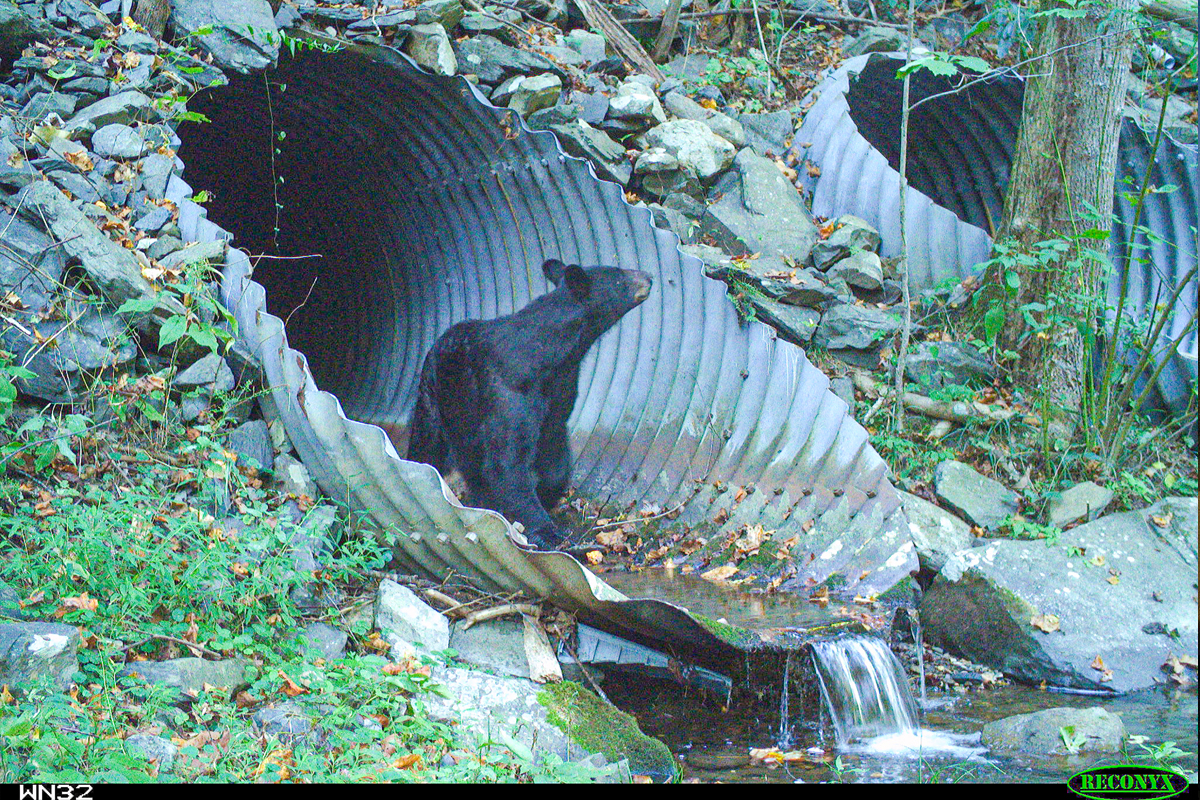AT license plates fund mini trail grants
The Appalachian Trail Conservancy will hand out mini-grants for projects in the region that benefit the long-distance hiking trail.
Grants can include trail work, conservation projects and trail promotion and education. Past projects have included:
• Efforts by the Nantahala Hiking Club to help the town of Franklin become an official “Trail Town.”
• Construction of a trail on the grounds of Cartoogechaye Elementary School in Franklin.
• Construction of a trail on the grounds of Summit Charter School in Cashiers.
• Trail maintenance and improvements to trail shelters.
• Bear cables at backcountry trail shelters.
• Controlling invasive, exotic plant species.
• Eforts to keep the bald on Roan Mountain from growing up, including a roving goat herd.
The Appalachian Trail Conservancy will give out $25,000 in grants, not to exceed $5,000 per grant. The grants are funded through proceeds from the specialty AT license plates, which raised $116,000 last year for the AT Conservancy.
Applications are due by March 5. Go to www.appalachiantrail.org/ncgrant.
Tales from the trail
Jennifer Pharr Davis, the female record-holder for the fastest thru-hike on the Appalachian Trail, spoke to a large crowd in the auditorium of Southwestern Community College in Sylva last week, enrapturing students with tales of her trail exploits.
While Davis has hiked many of the world’s most glamorous trails, from the Inca Trail in Peru to Mount Kilimanjaro, the trail with the most stories is the one right here in the students’ backyard.
Davis’ record-setting hike in 2008 was actually her second trip along the trail. Her first was in 2005 upon graduating from college. She was a mere two weeks into the trail somewhere outside Franklin when she was struck by lightning, emerging shaken but uninjured. A week later, she was crossing one of the toughest, highest sections of the trail through the Great Smoky Mountains National Park when a blizzard struck.
“I had a couple Pop-Tarts and a little bit of peanut butter and that was it. I knew I had to make it out of the Smokies,” Davis said.
Her remaining trail miles through the park were mostly downhill, so she turned her boots into cross-country skis. Sleet was driving against one side of her face, like razor knocks in her skin. She lowered her head and closed one eye on the windward side.
“It was hard because the AT is marked with white blazes and everything that I saw was white.”
When she got into protection of the forest canopy, the eye she’d shut was frozen closed.
“The rain and snow had congealed in my eye, and I couldn’t open it,” Davis said.
The elements weren’t the only challenges Davis encountered during her 2005 expedition. The Appalachian Trail is not quite the respite from society most would assume.
“There are lots of people on the trail, lots of friendly people on the trail, lots of young males who are especially friendly on the trail,” Davis said.
Davis was usually able to shake unwanted hiking companions by virtue of her pace, except for one tag-along in the Virginia section.
“He walked anywhere he could near me for 10 days,” Davis said. Like any good Southerner, Davis deployed a litany of subtle hints, but they were lost on him.
“I would say things like ‘I really like being a solo hiker,’ and he would say ‘Yeah, me too,’” Davis said. “I didn’t know how to get rid of him. At one point I hid under a rhododendron bush hoping he wouldn’t see me.”
Davis finally had to put her good Southern manners aside and tell him bluntly. The skill of direct communication continued to serve Davis well on a trail that can sometimes be intimidating for young single women.
Davis had a troubling experience on the trail in New Jersey that brought her hike — and her life — into a new focus. She came upon a man who had committed suicide in the middle of the trail. She didn’t know the cause at the time, however, only that she had stumbled upon a dead man.
“I pulled out the cell phone my mother insisted I carry as fast as I could,” Davis said.
She called 911 as she ran down the trail away from the spot. The experience had her brooding for days, feeling alone and scared. Word traveled in the trail community of her disturbing encounter. Within a couple weeks, the mother of a fellow hiker called Davis and offered to put her up for a few days at their Connecticut home, allowing Davis to regroup mentally.
“That epitomizes the trail community,” Davis said. “Even when you go through tough things someone will come along to lift you up and care for you and love you and often times it is a complete stranger. The trail actually restored my faith in humanity.”
Davis has launched Asheville-based Blue Ridge Hiking Company, where she trains potential thru hikers for their 2,000-mile journey. She also conducts workshops, talks and programs for groups. She has a book due out in 2010.
The need for speed AT record-setter enjoys simplicity of fast, solo hiking
Jennifer Pharr Davis says she never set out be a speed hiker.
When she first hiked the entire Appalachian Trail in 2005 at the age of 21, she was mostly looking for an excuse not to get a job right after graduating from college.
But she soon found she had a natural proclivity for hiking fast.
“I have this inner thing where I just love going all day on the trail as hard as I can,” Davis said. “I just really, really like the hiking part.”
Some people write journals on the trail, others linger at trail shelters over a game of cards with fellow hikers. But for Davis, an Asheville resident, it was all about the hiking: the physical act of moving through the woods and covering ground.
Three years later and with several other long-distance trails under her belt, Davis returned to the AT to hike it once more, this time at a record-setting pace for women.
Davis, who lives in Asheville and was born and raised in Hendersonville, completed the 2,175-mile trail in 58 days — just five days behind the men’s record and 30 days faster than any other woman. Only five men have done the trail faster.
To make that kind of speed, Davis had help, of course. Her husband shuttled her gear between trailheads, meeting her each night at points where the trail intersected with roads with food, water and tent and clean clothes. Her devoted one-man support crew allowed Davis to drastically lighten her load compared to the average AT hiker. She carried a small daypack or some days just a hip pack packed with the barest essentials. She was also freed from housekeeping details like setting up and striking camp, restocking groceries or doing laundry.
“Trust me, I am paying him back, probably for the rest of my life,” Davis joked.
Plotting meet-up points often meant relying on backwoods forest service roads, which sometimes led to confusion. Occasionally, she would arrive at the designated spot only to find he wasn’t there. Perhaps she had arrived early, making better time than expected. Or maybe she arrived late, and her husband had gone ahead to the next meet-up point looking for her.
On one occasion, the road was washed out and Davis’ husband had to load gear into a pack and run in to find her. Another time, the road they pinpointed on a map didn’t actually exist.
Expecting these missed connections, both Davis and her husband carried surveyor’s tape and a Sharpie to leave messages.
The thought of her husband waiting at the trailhead, often playing the guitar while he waited for Davis to show up, was one of the strongest motivators pulling her along the trail each day. The two had been married just days before embarking on the trip.
“I was crazy in love with my husband. I wanted to get to him as quickly as possible,” Davis said.
Of course, Davis also looked forward to the food he had waiting. At Davis’ record-breaking pace, she burned 4,000 calories a day, which meant she had a lot of consuming to do.
“If you are eating that much every day it becomes a job,” she said. “Honestly, I got sick of chewing.”
Davis defends her fast hiking to critics who question how much communing with nature one can honestly do at that pace.
“People say you didn’t appreciate it, you didn’t stop to smell the roses, you didn’t see the same things that people see when they hike slowly,” Davis said. “That’s not true.”
Davis ran some, but mostly just walked fast. She averaged 3 miles an hour, still a brisk pace considering the terrain and the inevitable bathroom breaks.
But by striking out at dawn and hiking through dusk, and moving quietly without companions, she saw more wildlife on her speed hike than three years earlier when she hiked at a standard pace — including 30 bears, compared to none on her 2005 hike.
Her final days on the trail became a whirlwind, however. Her husband, Brew, is a middle school teacher in Asheville and had to return home for the start of the school year. So two veteran AT hikers pitched in as a support crew in the final days. One of the trail greats enlisted was David Horton, the men’s record holder on the AT who completed the journey in 52 days after four tries. The other was Warren Doyle, who has thru-hiked the AT 15 times, more than anyone else.
She covered 205 miles her last four days, largely due to a perhaps overly encouraging support crew.
“What I remember is getting to the meet-up point just to see them drive off and say see you at the next road,” Davis said. She got in the car after finishing the trail and promptly fell asleep.
Davis doesn’t discount the possibility of another record hike, perhaps even going after the men’s record. Once the AT is in your blood, it’s hard to shake, she said. Not that she didn’t try after her first hike back in 2005. When she’d reached the summit of Mount Katahdin, which marks the end of the Appalachian Trail in Maine, she vowed never to repeat it.
“I climbed up that mountain and said ‘This has been a good experience. I am glad I did it, but I am never going to do it again — not even an overnight.’ Maybe a day hike but that was it,” Davis said.
She got a job doing marketing and special events at the Ash Lawn-Highland museum home of James Monroe, the fifth president, in Charlottesville, Va. But she soon found the trail calling.
“I was missing the simplicity of it. I was missing having everything I needed just on my back. I missed the self-reliance, looking to myself and depending on myself to make it through every day,” Davis said.
Davis, who graduated from Samford University in Birmingha, Ala., and played college tennis, also realized how much multitasking was involved in normal life.
“On the trail all I had to do was hike. It was so simple and I missed it,” Davis said.
Over the next three years, she hiked Mount Kilimanjaro, the 2,650-mile Pacific Crest Trail, the 600-mile Bibbulmun Track in Australia, the Inca Trail in Peru, and the 272-mile Long Trail in Vermont.
She worked in between trips but always with the next hike in mind.
“I just worked to hike and worked to hike,” Davis said. “Obviously by this point it was becoming an addiction.”
In search of hidden lookout towers
The line-up of hikes in the Lookout Tower Challenge spans Western North Carolina. Seven are located in the Nantahala National Forest, including Wayah Bald and Albert Mountain along the Appalachian Trail.
Five more towers can be found in the Great Smoky Mountains National Park, including Shuckstack, overlooking Fontana Dam, and Clingmans Dome, atop the highest peak in the park. And the Blue Ridge Parkway provides access to several more towers, like Fryingpan Mountain near the Pisgah Inn or Green Knob near Mt. Mitchell. Even the newly constructed tower atop Mt. Mitchell, eastern America’s highest peak, is included in the Challenge.
Hikers who make it to all 24 lookouts get an embroidered hiking patch and a certificate of completion from the Carolina Mountain Club. They also receive formal recognition at the hiking club’s annual dinner banquet and inclusion in its newsletter. But the greatest reward is the magnificent vistas afforded by the towers.
Here’s a list of all 24 towers in the challenge:
Nantahala mountains: Wayah Bald, Wesser Bald, Albert Mountain, Yellow Mountain, Panther Top, Cowee Bald, Joanna Bald.
Great Smoky Mountains National Park: Clingmans Dome, Shuckstack, Mt. Cammerer, Mt. Sterling, Mt. Noble.
Blue Ridge Parkway: Fryingpan Mountain, Green Knob, Mt. Mitchell, Barnett Knob, Flat Top Mountain.
Other Towers: Little Snowball, Rendezvous Mountain, Moores Knob, Chambers Mountain, Bearwallow Knob, Rich Mountain, Camp Creek Bald.
Hiking the AT: A journey of mind, body, spirit
By Josh Mitchell • Staff Writer
The bad economy may be good for business along the Appalachian Trail.
The AT typically attracts recent college grads, young people taking a break from their jobs, and a growing number of retirees. This year another group is hitting the trail — laid-off workers.
Every year at this time hundreds of hikers pour through Western North Carolina as they make way their way to the end of the trail.
Last Thursday The Smoky Mountain News caught up with dozens of hikers in Hot Springs, which the trail runs directly through, and talked to them about their journeys.
Doug McPherson of Sylva said when his employer told him to take a hike he did, literally. McPherson was employed by Harrah’s Cherokee Casino, and as soon as he was laid off he seized the opportunity to take on the trail.
Andy Crow of Pennsylvania had enough of college and needed a break. He didn’t want to take the typical route of graduating high school, going to college and getting a job.
Crow, who was majoring in geology before dropping out, said his parents were “cool” with his decision to hike the Appalachian Trail and put his conformist future on hold. Other hikers agree with Crow, saying hiking the AT represents another life experience they can rack up before they die.
Hiker Kim Morley was sitting down with her friends from New Zealand and ordered up a Trail cheeseburger at the Smoky Mountain Diner after being on the trail the past few days.
Morley, an employee with an environmental consulting company in Atlanta, plans to hike the entirety of the Appalachian Trail, which begins in Georgia and ends in Maine for a total of about 2,200 miles.
Morley’s New Zealand friends had gotten six-month visas so they could hike the entire trail, but they are bowing out due to an injury.
The New Zealand couple, Merryll Burr and Ron Burr, said hiking the trail is more difficult than they thought it would be. They first became acquainted with the trail about 15 years ago when they were in the area for a conference and hiked part of it.
At that time they decided they would try and do the whole thing one day. They were on their way until Ron sustained a shoulder injury that precludes him from being able to carry his pack.
Poor weather conditions have beaten down hikers this year as they battle through snow, wind, hail and freezing temperatures in the Smokies. When Morley gets back on the trail it will be four or five days before she reaches the next town.
Two other hikers, Alan Sloe and Kyle Fiasconaro, don’t have much money, so they were earning their keep at a hostel by moving timber.
Fiasconaro, from Long Island, N.Y., was working as a chef when he left everything behind to hike the trail. Hiking the trail seemed like the right thing to do rather than get “sucked into a career,” Fiasconaro said.
Sloe, from Greenville, S.C., said he didn’t have a career and agreed that hiking the trail is a good way to meet interesting people and see the mountains. The two met the first day on the trail.
While they were working they had a small tape player emitting music as their Pabst Blue Ribbon beers rested on cinder blocks.
Fiasconaro bemoaned that he has only $1,000 to make it to the end of the trail and said earning his keep at hostels by doing odd jobs is the only way he’ll make it.
Their mantra is to stay positive despite dramatic highs and lows that the trail brings, like the 2- to 4-foot snowdrifts they ran into. Luckily, they were able to stay overnight in a friend’s condo in Gatlinburg to get through that night.
All of the hikers have a trail name that gives them a separate identity from the one they have in the modern world. A hiker log at the Hot Springs Post Office lists hundreds of different trail names that have come through over the years including Hippie Chick, Grizzly, and Chaos.
Rob Phillips, from Lehman, Penn., goes by the trail name Tank, which is appropriate seeing that he’s endured rain, snow and thunderstorms so far. Many of the hikers on the trail are either recent college graduates or retirees.
Phillips said he wanted to take a year off school and hike the trail before returning to get his master’s degree. He was hiking out of Hot Springs on the way to Erwin, Tenn., which is the next town and 70 miles away.
Hikers do the trail for different reasons. Keith Hubbard, who goes by the trail name Huck Finn, said he simply loves the outdoors.
“I’m not trying to find myself,” he said.
Hubbard just graduated from college in Indiana where he earned his degree in physics. His parents are very supportive of him hiking the trail and putting the real world on hold, he said. Family members keep up with how he is doing through a blog he updates at libraries when he comes into trail towns.
The camaraderie of like-minded people on the trail and the beauty of the mountains make hiking the trail worth it, even on bad days, said Hubbard.
With only $1,000 he is on the low end in terms of how much money is needed to hike the trail. He didn’t engage in much preparation for the journey; he basically put on a backpack and started hiking. In his pack he carries a one-man tent, sleeping bag, rain jacket, lightweight pants and shirt, stove and a fuel can.
The northeast is the part of the trip he is looking forward to the most since he has never been to that part of the country.
Inside the Hot Springs library, Michael Given of Maine sat at a table looking through an Appalachian Trail book. He said he was abandoning the trail, but his 65-year-old mother is continuing on to the end.
He said hiking with his mom part of the way was his way of showing her that he supported her in her journey. Being on the trail was a great adventure, said Given. “It was like going to a different country,” he said.
Surviving the trail is 90 percent mental, he said. He and his mother were hiking 22 miles a day, although, “mother and I are pretty tough Mainers.” His mom has run a marathon on every continent, he said.
Getting through the trail requires organizing mail drops at post offices along the way to replenish supplies, he said. He and his mother were getting their water from creeks after cleaning it with water purifications pumps, he said.
He was a much faster hiker than his mother, which meant he would get far ahead of her and then have to let her catch back up with him. This earned him the trail name “Leap Frog.”
John Conlin and his friend, Bert McAdam, were sitting down to eat at the Smoky Mountain Diner, exhausted from hiking and hungry for a hearty meal.
“Don’t mind the odor, but I’ve been out in the woods for five days,” said Conlin.
Conlin and McAdam didn’t know each other prior to hiking on the trail but now seem like they’ve known each other a lifetime. Both men are from Florida and plan on hiking the entire trail as they now have the time being retired.
“I’ve been wanting to do this for 30 years,” said Conlin. “I retired a year early so I could do this.”
Hiking the trail can give one a voracious appetite, Conlin demonstrated as he ordered up a double cheeseburger and a grilled cheese sandwich.
The Appalachian Trail represents a personal challenge that Conlin and McAdam want to overcome. They recalled the deep snow near Gatlinburg, and how 17 people were trapped under a ledge during a snowstorm. Several had to be treated for frostbite, Conlin said.
Conlin, being a Floridian, goes by the trail name Gator, while McAdam goes by Rusty, which, he says, is a comment on his physical shape. Both men are 65 and said taking on the trail is an adventure that gives them a sense of accomplishment.
Conlin commented that he has the financial resources to do the trail while some of the younger hikers are operating on a shoestring. He has given some of them food. To prepare for the journey Conlin said he researched the trail over a year and lost 12 pounds.
Hikers drop many pounds on the trail as they eat granola and hike 20 miles a day. As Conlin sat at the diner’s table, he said coming into trail towns is great because it means high-carb, high-fat meals to be washed down with iced tea and milk.
“You dream of getting here,” he said.
After hiking 14 hours a day for the past few days, McAdam and Conlin said they will take a “zero day,” which means they will stay in town to rest, do laundry and get supplies.
Hiking every last trail in the Smokies, and then some
By Danny Bernstein
For the past year, I’ve kept a trail map of the Smokies and the trusted manual Hiking Trails of the Smokies, known affectionately as the brown book, stashed in the seat pocket of my car.
The telephone number for the road conditions is on my speed dial and I am on a first name basis with several rangers in the Great Smoky Mountains National Park.
With my all-consuming endeavor to hike every trail in the Smokies now complete, I have become the 248th member of the 900 Miler Club. Though the club is called 900 Miler, there are now only 800 miles of maintained trails in the park, as shown by the GSM Trail Map. But you need to walk a lot more than 800 miles to do them all — some say 1,500 miles.
For all that effort, I only got a patch to sew on my pack — and bragging rights, of course. Logistically, it’s the most complicated hiking challenge I’ve done but physically it was not difficult. The Smokies are so well maintained that you can get really spoiled. Mile for mile, the Smokies trails are easier than the surrounding national forests.
When I moved to WNC, I had already done the 71.4 miles of the Appalachian Trail that traverse the park and knew how beautiful the trails were. I was thrilled to live so close to the Smokies. I then hiked a lot of easy miles, most on the perimeter of the park — what I call the top of the pops: Ramsey Cascades, Little Cataloochee Trail, the Deep Creek/Martin Gap/Indian Creek loop, Hemphill Bald and all the Mt. LeConte Trails.
I then did some obscure and fascinating hikes that only a 900-mile aspirant would do, like Brushy Mountain with its good view of Gatlinburg, Grapeyard Trail with its train engine remains and up to Gregory Bald from Twentymile Ranger Station. About that time, I finished the South Beyond 6000 which gave me the Balsam Mountain Trail. I went to the Great Smoky Mountains Institute at Tremont several times and got a lot of pesky miles off Little River Road. One year, they organized a long shuttle from Clingmans Dome on the Sugarland Mountain Trail. Part of the challenge is to find other obsessed hikers so you can set up shuttles.
The two watershed backpacks were from the Fontana Marina, probably the most remote part of the park: the first was Eagle Creek and down Jenkins Creek. The second was a long loop involving Cold Spring Gap Trail, up Welch Ridge and down Hazel Creek. To me, those were the big challenges; I felt that if I could get those out of the way, I would finish.
But after those backpacks, I looked at the map yet again and the goal seemed even more impossible. I set up backpacking trips and people canceled. It rained and others canceled. Then I realized that I could do 18-plus miles a day by myself and it was no big deal. The last three months, I hiked 120 new miles. I had to repeat many more miles to reach the inner trails. For example, to reach Pole Road Creek Trail between Deep Creek and Noland Divide Trail, I had to rewalk seven miles.
I finished on the Indian Creek Motor Trail, a minor trail out of the Deep Creek entrance; it was important for me to finish on the North Carolina side. I will never know the park as well as I do now. So why did I do it?
• To really understand the park and how all the trails are connected. Before I moved to Western North Carolina, the Smokies to me was the Sugarlands entrance from Gatlinburg.
• Because it was there and the next obvious hiking challenge. It’s important to keep hiking little-known Smokies trails or the park may decommission them.
Like any challenge on the trail or in life, it’s not about physical strength or stamina. Hiking all the trails in the Smokies is all about perseverance, organizing and keeping your eye on the goal. But finishing any hiking challenge is bittersweet — grateful I’m done and sad that I don’t have to get out there anymore.
But now my husband caught the Smokies 900 bug and he has 200 miles to go. So I’m back in the park to help him.
Danny Bernstein, a hike leader and outdoor writer, is the author of Hiking North Carolina’s Blue Ridge Heritage (2009) and Hiking the Carolina Mountains (2007). She can be reached at This email address is being protected from spambots. You need JavaScript enabled to view it..
What’s a hiking challenge?
There are a host of hiking challenges that trail hounds in WNC can tackle. The 900 Miler Club, the endeavor to hike every mile of trail in the Great Smoky Mountains National Park, is one of the longest running. But there’s a few others.
• South Beyond 6,000, or SB6K: hike to the top of all 40 peaks in the Southern Appalachians that’s over 6,000 feet.
• Pisgah 400: hike all 400 miles of maintained trail in the Pisgah National Forest. About 120 trails.
• Lookout Tower Challenge: Hike to 24 fire towers in WNC.
• Waterfall 100: Hike to 100 predetermined waterfalls and cascades in WNC.
For details on the hiking challenges, go to carolinamtnclub.org and look for “challenges” on the left hand side.
Franklin seeks AT town designation
Franklin’s role on the Appalachian Trail
Franklin is an important town on the Appalachian Trail because it is one of the first or last towns depending on which direction you’re coming from. It is about 106 miles from the start.
Nantahala Hiking Club President Bill Van Horn said if hikers make it to Franklin, chances are they can hike the entire trail.
The trail is 2,175 miles long and runs from Georgia to Maine.
About the Nantahala Hiking Club
The NHC is one of 30 trail clubs that maintain the 2,175 miles of the Appalachian Trail The NHC maintains 60 miles of the AT and 47 of those miles are in Macon County. The NHC, based out of Franklin, has a membership of more than 240. From October 2007 to September 2008, the club’s membership contributed more than 5,300 volunteer hours to maintain the AT and promote hiking.
Every spring, hundreds of Appalachian Trail hikers pass by the doorstep of Franklin en route from Georgia to Maine, many hitting town to buy supplies, clean up, check into a hotel and generally take a break from the trail.
But the town could do more to capitalize on its proximity to the A.T. A push is underway to seek designation as an official Appalachian Trail Community Partner, clearly associating the town with the world-famous trail.
In essence, it would make Franklin a “gateway city” on the trail, showing that Franklin welcomes hikers.
The Nantahala Hiking Club, which is leading the charge in making Franklin an AT Community Partner, believes Franklin and Macon County are not taking advantage of the Trail’s economic potential.
According to the hiking club, over 1,800 hikers pass through Macon County between March and May each year, and the Nantahala National Forest has one million day visits a year.
If Franklin achieves the designation and lures more hikers to ventuer the 10 miles into town and use it as a stop over, the trail could prove an economic boon.
The path to being an AT Partner
For Franklin to qualify it must meet at least two of four criteria, although Nantahala Hiking Club President Bill Van Horn said the town will probably meet all four.
The Appalachian Trail Conservancy, which sponsors the program, is expected to decide in April whether Franklin receives the designation.
One requirement is establishing an advisory committee that focuses on the Appalachian Trail and the community. Groups such as the town, the county, the Chamber of Commerce and the schools may be interested in having a representative on the committee.
In order to receive the designation Franklin must also host an annual AT event.
Franklin already has an established event with the April Hikers Fools Bash put on by Ronnie Haven at the Sapphire Inn.
This will be the fifth year for the event that features music, food, and hiking vendors. The event allows hikers and community members to come together; last year about 1,500 attended.
During the hiking season, Haven runs a free bus service that picks up hikers at the trail and drives them into town to get supplies.
Franklin deserves to be designated an AT Community Partner given how much it offers hikers, said Haven.
He said the town has one of the nicer outfitters along the trail with Three Eagles Outfitters, grocery stores, drug stores, medical facilities, a movie theater, museum and post office.
Another requirement to becoming an Appalachian Trail Community Partner is using the trail for educational purposes.
Van Horn suggested fifth grade classes taking annual field trips to the trail could meet this requirement. He added that the trail offers a great opportunity to combine physical education and science.
And the final requirement deals with installing language in city and county ordinances that protects the trail from development.
The county could state in its ordinances that the Appalachian Trail Conservancy will be notified and included whenever there is a proposal to impact the trail, Van Horn said.
Examples of developments that may disturb the trail are erecting wind turbines and cell phone towers nearby, Van Horn said.
A symbiotic relationship
One benefit of designation is simply increasing awareness that the trail is near Franklin and easy to access. If Franklin receives the designation there may be signs displayed in town identifying Franklin as an AT Community Partner.
Franklin would be one of the first to receive the distinction. The towns of Hot Springs, N.C., Boiling Springs, P.A., Erwin, Tenn. and Unicoi County, Tenn. were designated Community Partners in a pilot program.
Another benefit is the additional publicity Franklin would receive nationwide from being a member of the program. The town would be highlighted on the AT Conservancy Web site — appalachiantrail.org — as well as in the organization’s press releases, trail guide and quarterly magazine “A.T. Journeys,” Van Horn said.
Franklin teachers could receive training and education on how to incorporate the Appalachian Trail into their lessons.
And another benefit is that Macon County teachers could take workshops from the AT Conservancy on “placed-based” education that deals with teaching students about the area they live. For instance, instead of learning about the Himalayas, students could learn about the “Nantahalas,” Van Horn said. The workshops are called “A Trail to Every Classroom.”
Teachers could also receive special training from the AT Conservancy in service learning to teach children about volunteering. For example, students could take a class on the Appalachian Trail and could adopt a mile of the trail to maintain.
New shelter graces Wayah Bald
After Ann McDuff was struck and killed while riding her bicycle in February 2003, her husband, Larry, spearheaded a money-raising effort to build a shelter in her memory along the Appalachian Trail.






















